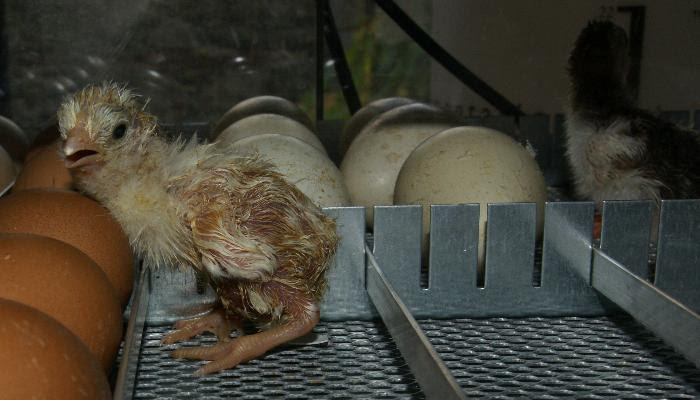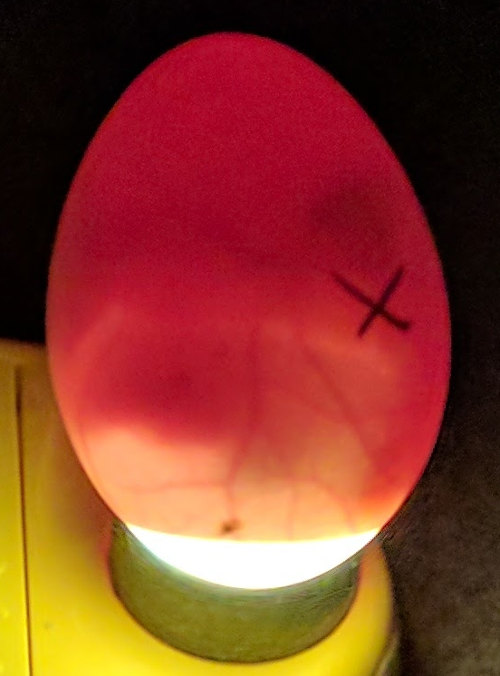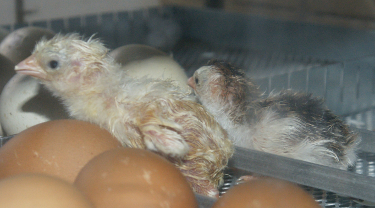Artificial incubation of Guinea fowl eggs.

What is the best way to incubate Guinea fowl eggs?
The best way to artificially incubate Guinea fowl eggs is in a forced air incubator at 99.1 F (37.4 C) for 28 days at a humidity level of 50%. The eggs must be turned at least three times a day and preferably five times a day.
Guinea Fowl eggs typically take 28 days of incubation at 99.1 degrees F with an ideal humidity level anywhere between 40%-50%.
In reality they can hatch anywhere between days 26 and 29. The eggs must be turned at least 3 times a day but 5 is better.
Can you mix Guinea fowl and chicken eggs in the same incubator?
You should never mix chickens and Guinea fowl eggs as they require different temperatures, humidity levels an incubation periods. This is a common reason for failure when incubating Guinea eggs, to high a temperature bringing on an early and staggered hatch.
Below: A successful hatch of Guinea fowl.

Temperature should be decreased by 1 F on day 25 and humidity increased to 55% and stabilised for hatching. A stable humidity is considerably more important than the final figure achieved.
Lock-down should be on day 25. It is important to keep the vents open for the hatch-lings to be able to breathe during hatching and turn the egg roller off or stop turning the eggs..
We know from studies of 5000 Guinea fowl eggs at a time in a commercial hatchery that the best temperature for incubation is 37.2 ± 0.1°C .
During incubating relative humidity in the range 40 to 64% significantly affected the total water loss and hatch-ling mass. Optimal relative humidity for the successful hatching of Guinea fowl eggs was calculated to be 48 to 52%.
The rate of ventilation significantly affected hatch rate. This is especially important when increasing humidity for the hatching phase when the practice is to close the air vents to increase humidity rather than increasing the surface area of the water in the incubator.
The age of the laying flock effects the final outcome. The best eggs are from birds in their second year.
Candling Guinea eggs:
Guinea fowl eggs are easy to candle. Their shells might be thick but they are light in colour. Be sure to do it in total darkness.
Below: An egg being candled with a bright light in a dark room.

Candle before incubation to check there are no faults with the egg like damaged air spaces, missing yolks or hairline cracks.
Candle on day 10 just as you would for chickens and remove any blood rings or clear eggs.
The air cell should always be at the big/fat end of the egg (Guinea eggs have a big round end and a very pointy small end).
Incubation at high altitudes:
At high altitude make sure the initial humidity is 45% during incubation. Bring it up to 60% at lock-down. Guinea eggs are pretty forgiving. At higher elevations the temperature can be as low as 36.4 C or 97.5 F with no ill effects on the keets.
Guinea egg hatchability:
I have found guinea eggs to have a slightly lower hatch rate than hens eggs. It is not uncommon to have a hatch rate of 65% to 75% of set eggs whereas it may be closer to 80 or 85% for chickens eggs.
Hatchability of Guinea fowl eggs starts really decreasing after 7 days. Cool eggs keep better but do not try to keep them longer than 10 days before incubating. Eggs for hatching should be turned regularly just as a hens eggs would be.
You don't want to put them in the incubator as soon as you collect them because you'll have a staggered hatch and that will mess with the humidity levels during hatching.
Turning Guinea eggs:
Be sure to turn them at least 3 but preferably 5 times a day or make use of an automatic egg turner to keep them moving.
Odd number of times is best as this means the egg is on a different side overnight. Mark one side of the egg with a cross or line.
If you forget just carry on as normal. One missed turning does not often effect the hatch rate.
Dealing with Rotten eggs:
The bubbling liquid dots coming out of an egg is probably a rotten seeping egg that may explode at any time.
Place a bag over your hand like a dog mess bag and pick the egg up really carefully.
Enclose and tie as fast as you can. Dispose of quickly. If it bursts it will stink enough to make you retch and will contaminate everything it comes into contact with.
What is incubator lock-down?
Lock-down is the last 3 days of incubation when you raise the humidity for hatch.
The term lock-down actually means keep the lid closed on the incubator until the hatch is over.
You should not lock the ventilation covers but use other methods to increase humidity in the incubator. You want that warm moist air to stay in there so the shells stay softer and the inner membranes stay moist.
Below: A keet drying in the incubator.

Lock-down is also the time to turn the egg roller off or stop turning the eggs.
It is also common practice to add surface area to the water reservoir in the incubator at this time. Keets need the extra moisture to be able to pip, spin in the egg and unzip to hatch, especially in a forced air incubator.
Pipping:
Pipping is when the keets that are developed far enough along to be ready to start hatching start pecking the inside of the shell and cracking it. Sometime it's just a crack at first, other times there is an obvious peck mark sticking up on the surface of the shell.
With pipped eggs I would always leave the incubator closed, stop fiddling with it just let them hatch.
You do want some fresh air flow coming into the incubator from the vents in the incubator, but the more cool dry air you expose the eggs to by opening the incubator the less of a chance there is of the keets hatching successfully.
Every time cool dry air gets to the eggs you run the risk of the inner membrane shrinking down over the keets, making it difficult or impossible for the keets to hatch, or even suffocating them.
What is a good fertility rate for Guinea fowl?
Fertility rates for Guinea fowl should be 80%. If yours are less than 70% I would investigate why.
Low fertility or hatch rates in Guinea fowl could be caused by:
- Condition of the parents.
- Age of the parents.
- Infertility.
- Poor storage of the egg before incubation.
- Genetic problems.
- Faulty incubator.
For a full list of the reasons eggs don't hatch see this article.
